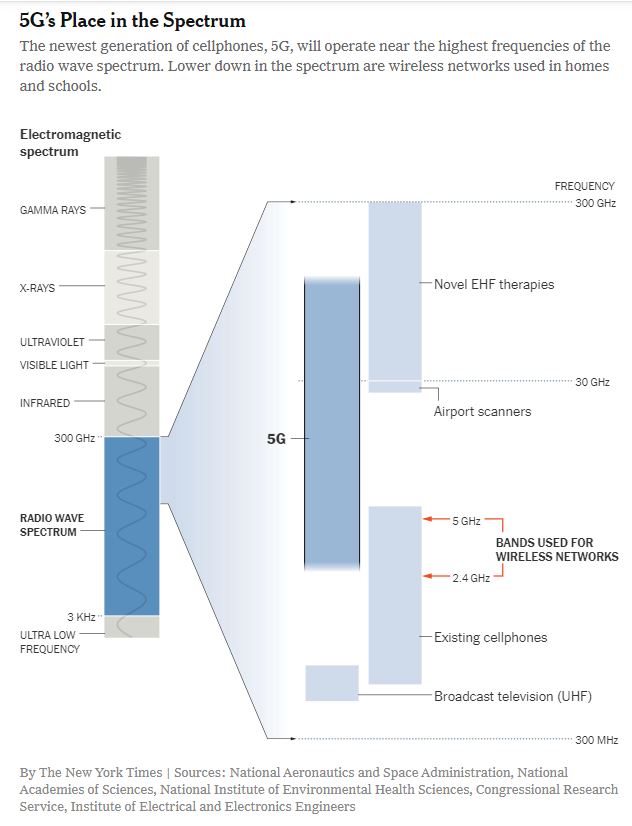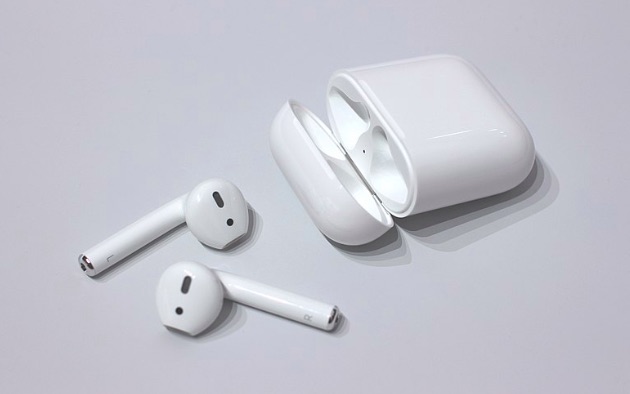A Sense of Doubt blog post #1715 - 5G and Cancer - Debunked?
For my presentation, which happens in two days...
https://www.nytimes.com/2019/07/16/science/5g-cellphones-wireless-cancer.html
The 5G Health Hazard That Isn’t
How one scientist and his inaccurate chart led to unwarranted fears of wireless technology.
In 2000, the
Broward County Public Schools in Florida received an alarming report. Like many affluent school districts at the time, Broward was considering laptops and wireless networks for its classrooms and 250,000 students. Were there any health risks to worry about?
The district asked
Bill P. Curry, a consultant and physicist, to study the matter. The technology,
he reported back, was “likely to be a serious health hazard.” He summarized his most troubling evidence in a large graph labeled “Microwave Absorption in Brain Tissue (Grey Matter).”
The chart showed the dose of radiation received by the brain as rising from left to right, with the increasing frequency of the wireless signal. The slope was gentle at first, but when the line reached the wireless frequencies associated with computer networking, it shot straight up, indicating a dangerous level of exposure.
“This graph shows why I am concerned,” Dr. Curry wrote. The body of his report detailed how the radio waves could sow brain cancer, a terrifying disease that kills most of its victims.
Over the years, Dr. Curry’s warning spread far, resonating with educators, consumers and entire cities as the frequencies of cellphones, cell towers and wireless local networks rose. To no small degree, the blossoming anxiety over the professed health risks of 5G technology can be traced to a single scientist and a single chart.
A 2000 graph by physicist Bill P. Curry purported to show that tissue damage increases with the rising frequency of radio waves. But it failed to account for the shielding effect of human skin.
Except that Dr. Curry and his graph got it wrong.
According to experts on the biological effects of electromagnetic radiation, radio waves become safer at higher frequencies, not more dangerous. (Extremely high-frequency energies, such as X-rays, behave differently and do pose a health risk.)
In his research, Dr. Curry looked at studies on how radio waves affect tissues isolated in the lab, and misinterpreted the results as applying to cells deep inside the human body. His analysis failed to recognize the protective effect of human skin. At higher radio frequencies, the skin
acts as a barrier, shielding the internal organs, including the brain, from exposure. Human skin blocks the even higher frequencies of sunlight.
“It doesn’t penetrate,” said
Christopher M. Collins, a professor of radiology at New York University who studies the effect of high-frequency electromagnetic waves on humans. Dr. Curry’s graph, he added, failed to take into account “the shielding effect.”
Dr. Marvin C. Ziskin, an emeritus professor of medical physics at Temple University School of Medicine, agreed. For decades, Dr. Ziskin explored whether such high frequencies could sow illness. Many experiments, he said, support the safety of high-frequency waves.
Despite the benign assessment of the medical establishment, Dr. Curry’s flawed reports were amplified by alarmist websites, prompted articles linking cellphones to brain cancer and served as evidence in lawsuits urging the removal of wireless classroom technology. In time, echoes of his reports fed Russian news sites noted for stoking misinformation about 5G technology. What began as a simple graph became a case study in how bad science can take root and flourish.
“I still think there are health effects,” Dr. Curry said in an interview. “The federal government needs to look at it more closely.”
An authoritative mistake
Dr. Curry was not the first to endorse the idea that advances in wireless technology could harbor unforeseen risks. In 1978, Paul Brodeur, an investigative journalist, published “The Zapping of America,” which drew on suggestive but often ambiguous evidence
to argue that the growing use of high frequencies could endanger human health.
In contrast, Dr. Curry’s voice was authoritative. He became a private consultant in the 1990s after
federal budget cuts brought
his research career to an end.
He had degrees in physics (1959 and 1965) and electrical engineering (1990). His credentials and decades of experience at federal and industrial laboratories, including the Lawrence Livermore National Laboratory, seemed to make him a very strong candidate to conduct the Broward study.
“He was a very bright guy,” recalled Gary Brown, an expert in the district’s technology unit who worked with Dr. Curry to prepare the reports. But Dr. Curry lacked biological expertise. He could solve atomic and electromagnetic puzzles with ease, but he had little or no formal training in the intricacies of biomedical research.
In 2000, Dr. Curry, writing on letterhead from
his home office in the Chicago suburbs, sent the Broward district two reports,
the first in February 2000 and
the second in September of that year. The latter study went to the superintendent, the school board and the district’s head of safety and risk management.
The frequency graph in the second report was far more detailed. Its rising line bore annotations noting the precise locations for the wireless-network dose and, far lower down, for radio, television and cellphone signals.

Over all, Dr. Curry’s reports cast the emerging topic as crucial for public health. He warned that children were especially vulnerable to the cancer risk of wireless technology. “Their brains are developing,” he noted in
his first report.
Dr. Carpenter’s credentials were impressive. He graduated magna cum laude
from Harvard in 1959 and cum laude from its medical school in
1964. From 1985 to 1997, he served as dean of the School of Public Health at the State University of New York in Albany, and in 2001 became director of its Institute for Health and the Environment, where he still works.
His resumé lists hundreds of journal reports, jobs, grants, awards, advisory boards, books and legal declarations.
Dr. Carpenter stirred global controversy in the 1980s by asserting that high-voltage power lines could cause leukemia in nearby children. He appeared as an authority in Mr. Brodeur’s 1989 book, “Currents of Death.” But federal researchers
failed to find solid evidence to support the warnings.
Dr. David O. Carpenter, a director of the Institute for Health and the Environment at the University at Albany.Credit...Lauren Lancaster for The New York Times
In late 2011, Dr. Carpenter introduced Dr. Curry’s graph in
a lawsuit that sought to force the Portland, Ore., public schools to abandon their wireless computer networks. The suit had been filed by a worried parent.
As an expert witness, Dr. Carpenter said in a
legal declaration on Dec. 20, 2011, that the graph showed how the brain’s absorption of radio-wave energy “increases exponentially” as wireless frequencies rise, calling it evidence of grave student danger. The graph “illustrates the problem with the drive of the wireless industry toward ever higher frequencies,” he said.
In response to such arguments, the industry noted that it obeys government safety rules. The judge in the Portland case said the court had no jurisdiction over federal regulatory matters, and
dismissed the lawsuit.
Despite the setback, Dr. Carpenter’s 2011 declaration, which included Dr. Curry’s graph, kept drawing attention. In 2012, he introduced it as part of
his testimony to a Michigan state board assessing wireless dangers, and it soon
began circulating online among
wireless critics.
And he saw a new danger. Between 2010 and 2012, the frequencies of the newest generation of cellphones, 4G, rose past those typical of the day’s wireless networks. Dr. Carpenter now had a much larger and seemingly more urgent target, especially since cellphones were often held snugly against the head.
“There is now much more evidence of risks to health, affecting billions of people,”
he said in introducing a 1,400-page report on wireless dangers that he edited
with an aide. “The status quo is not acceptable.”
His
BioInitiative Report, released in late 2012, gained worldwide notice. But mainstream science rejected its conclusions. Two Oxford University researchers
described it as “scientifically discredited.”
A ‘fact’ is born
Unbowed, Dr. Carpenter worked hard to revise established science. In 2012, he became editor in chief of
Reviews on Environmental Health, a quarterly journal. He published
several authors who filed alarmist reports, as well as his own.
“The rapid increase in the use of cellphones increases risk of cancer, male infertility, and neurobehavioral abnormalities,”
Dr. Carpenter wrote in 2013.
In subsequent years, as the frequencies of wireless devices continued to rise, an associated risk of brain cancer was repeated uncritically, often without attribution to Dr. Curry or Dr. Carpenter. Instead, it came to be regarded by activists as an established fact of modern science.
“The higher the frequency, the more dangerous,” according to Radiation Health Risks, a website, in reference to
signals from 5G towers. The idea was echoed by a similar website, 5G Exposed — “Higher frequencies are more dangerous to health” —
on a page entitled “Scientific Discussion.” Over all, the site bristled with brain-cancer warnings.
Recently, Dr. Carpenter
told RT America, a Russian television network, that the newest cellphones represented a dire health threat. “The rollout of 5G is very frightening,” he said. “Nobody is going to be able to escape the radiation.”
In recent months, the network has run a series of segments critical of 5G technology. “The higher the frequency, the more dangerous it is to living organisms,” a RT reporter told viewers in March. The show described children as particularly vulnerable.
The new cellphones are to employ a range of radio frequencies up to dozens of times higher than those Dr. Curry identified two decades ago as endangering student health. But mainstream scientists continue to see no evidence of harm from cellphone radio waves.
“If phones are linked to cancer, we’d expect to see a marked uptick,” David Robert Grimes, a cancer researcher at the University of Oxford,
wrote recently in The Guardian. “Yet we do not.”
In a recent interview, Dr. Carpenter defended his high-frequency view. “You have all this evidence that cellphone radiation penetrates the brain,” he said. But he conceded after some discussion that the increasingly high frequencies could in fact have a difficult time entering the human body: “There’s some legitimacy to that point of view.”
He noted that, in cities, 5G service requires the placement of many antenna towers, because walls, buildings, rain, leaves and other objects can block the high-frequency signals. “That’s why they put the towers so close together,” he said. “The waves don’t penetrate.” If human skin also blocks 5G signals, Dr. Carpenter acknowledged, “maybe it’s not that big a deal.”
Dr. Curry, now 82, was less forthcoming. In an interview, he said he no longer follows the wireless industry and disavowed any knowledge of having made a scientific error.
“They can say whatever they want,” Dr. Curry said of his detractors. “I’ll leave it to the young in the business and let them figure it out.”
Earlier reporting on health misinformation
William J. Broad is a science journalist and senior writer. He joined The Times in 1983, and has shared two Pulitzer Prizes with his colleagues, as well as an Emmy Award and a DuPont Award. @WilliamJBroad
+++++++++++++++++++++++++++++++++++++++++++++++++++++++++++++++++++++++
+++++++++++++++++++++++++++++++++++++++++++++++++++++++++++++++++++++++
+++++++++++++++++++++++++++++++++++++++++++++++++++++++++++++++++++++++
- Bloggery committed by chris tower - 1910.29 - 10:10
- Days ago = 1578 days ago
- New note - On 1807.06, I ceased daily transmission of my Hey Mom feature after three years of daily conversations. I plan to continue Hey Mom posts at least twice per week but will continue to post the days since ("Days Ago") count on my blog each day. The blog entry numbering in the title has changed to reflect total Sense of Doubt posts since I began the blog on 0705.04, which include Hey Mom posts, Daily Bowie posts, and Sense of Doubt posts. Hey Mom posts will still be numbered sequentially. New Hey Mom posts will use the same format as all the other Hey Mom posts; all other posts will feature this format seen here.






























